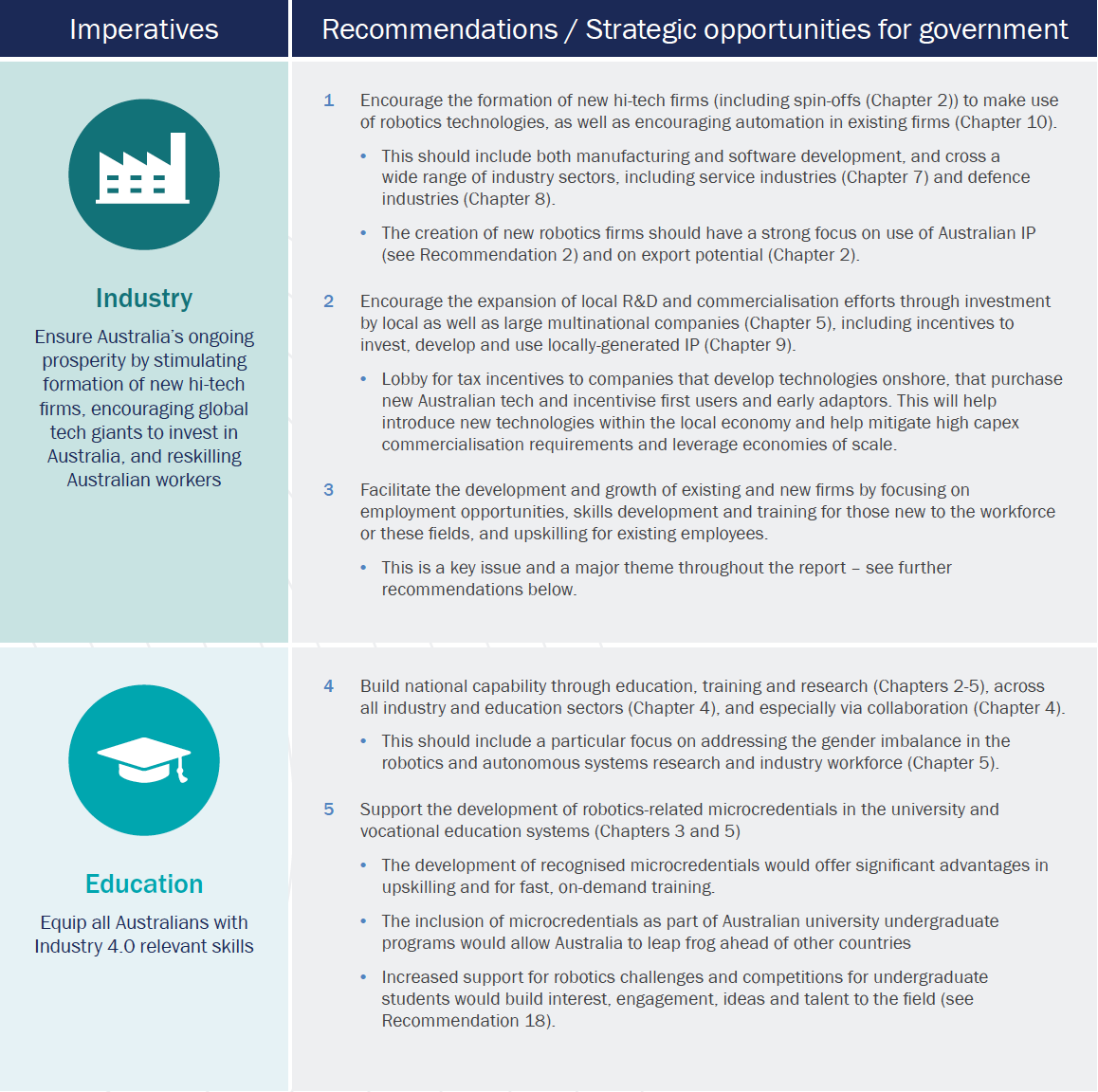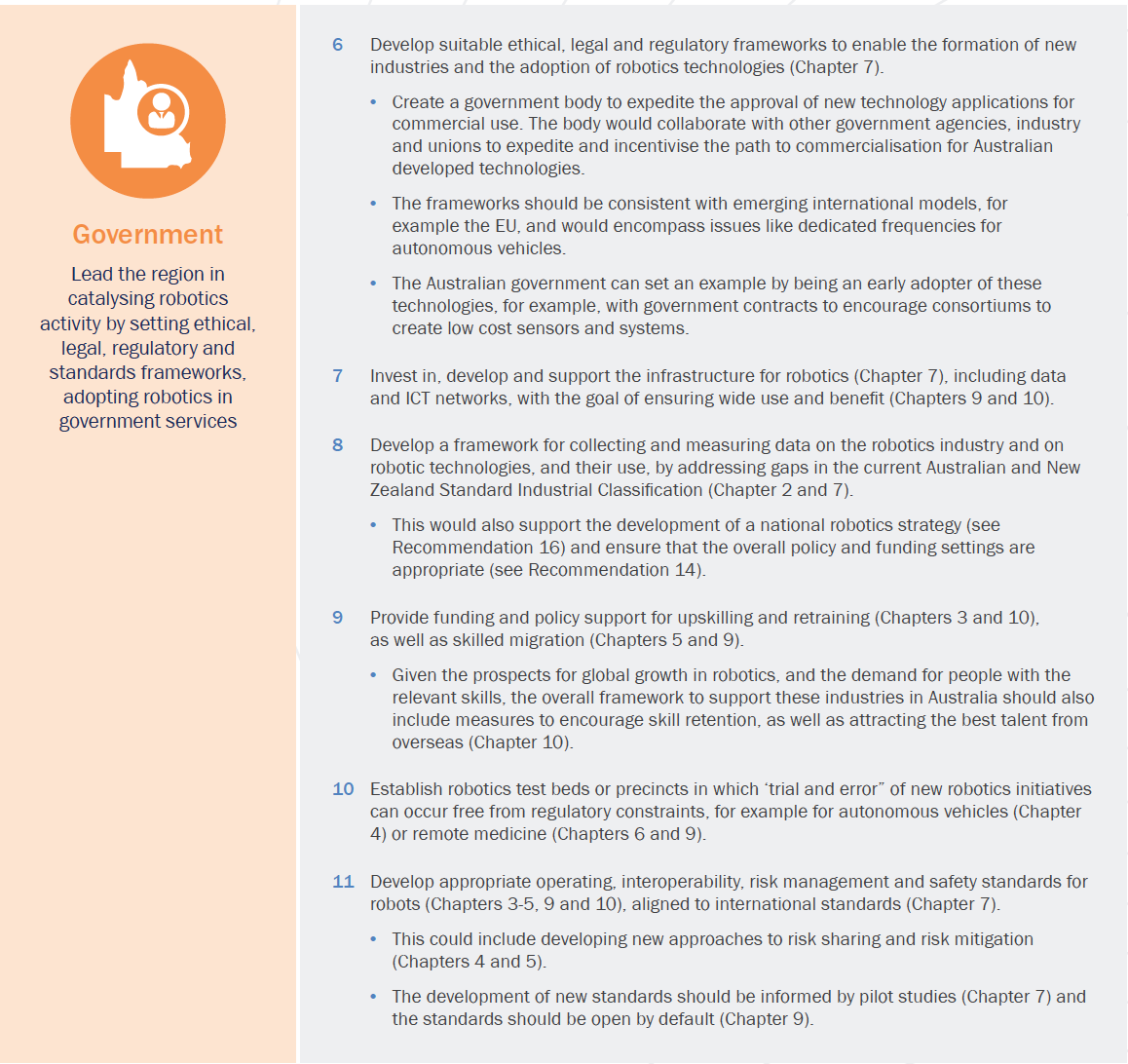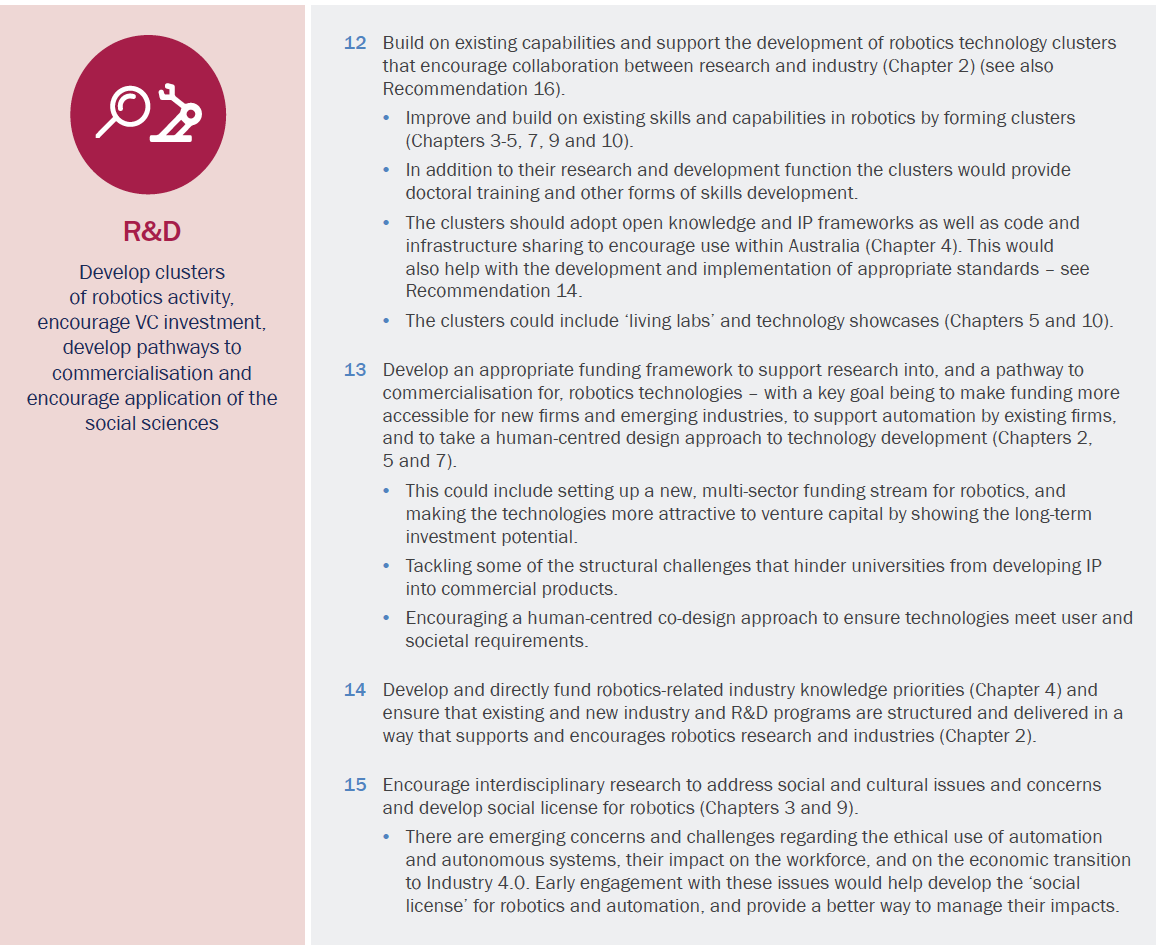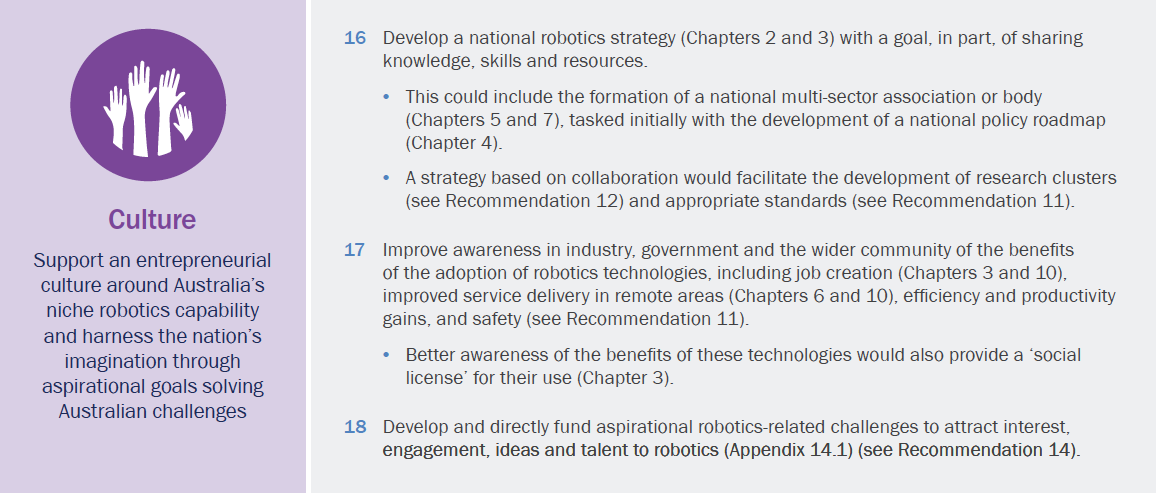
EXECUTIVE SUMMARY
VISION: Robots as a tool to unlock human potential, modernise the economy, and build national health, well-being and sustainability
Robotics in Australia will maintain our living standards, help protect the environment, provide services to remote communities, reduce healthcare costs, provide safer more fulfilling jobs, prepare the next generation for the future, encourage investment and reshore jobs back to Australia. The Australian Centre for Robotic Vision, an ARC Centre of Excellence, has partnered with industry, researchers and government agencies across the country to develop Australia’s first robotics roadmap.
This document is structured to give an overview of robotics in Australia, an overview of the issues that greater take-up creates and then a sectoral breakdown of current activity and future outlook. Each chapter is informed by participation from industry. We highlight some of the bright spots – the applications of robotics across industries, which can be an exemplar for further progress. These case studies are drawn directly from real-life experiences. And we acknowledge two important and successful paths to innovation, the use of clusters and challenges to bring together complementary skills to solve problems and develop new technologies. They’re worth pursuing.
Our national consultation process was modelled on Professor Henrik Christensen’s successful US Robotics Roadmap, now in its 3rd Edition [USR16]. During late 2017 and early 2018 we held a series of workshops, in different capital cities, focussing on areas of economic significance to Australia. Robotic technologies can be deployed across all sectors, and each sector has distinctive requirements that we will explore in this roadmap. We concentrate on sectors where robotics technologies can have the greatest impact either by virtue of the sheer size of the sector, the scale of transformative effect of the technologies, or the opportunity to solve Australia’s unique challenges.
Over the next decade a range of new technologies will see robots that are more tactile, more capable of interacting with their physical environments, more closely working with humans and more self-sufficient. Robots will also take on many different forms, suiting them for new and unexplored functions. This roadmap is a guide to the future of robotic technologies and how we can achieve gains from them across all sectors of the Australian economy. Like any roadmap, it doesn’t mandate direction. But it does show the start point and the possible end points through the range of journeys Australians and our industries can take. And there are many directions and many social and economic issues to consider if we are to advance.
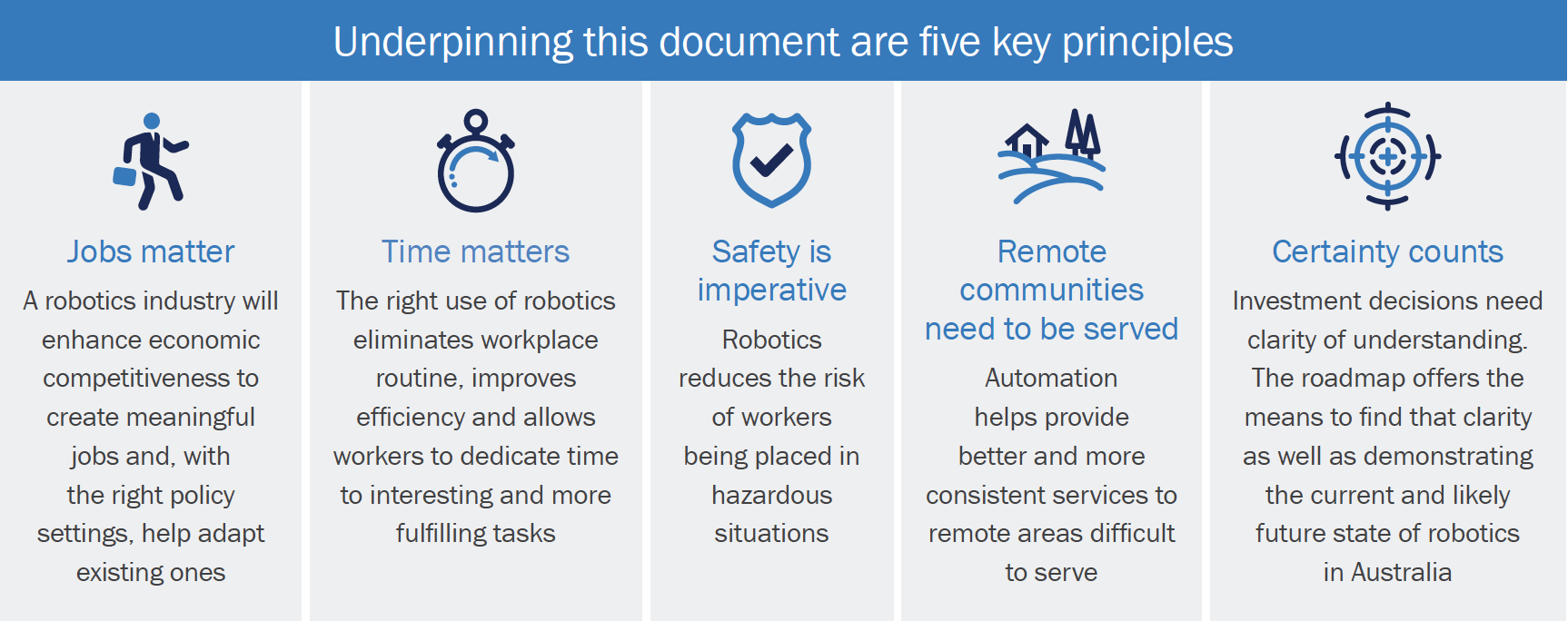
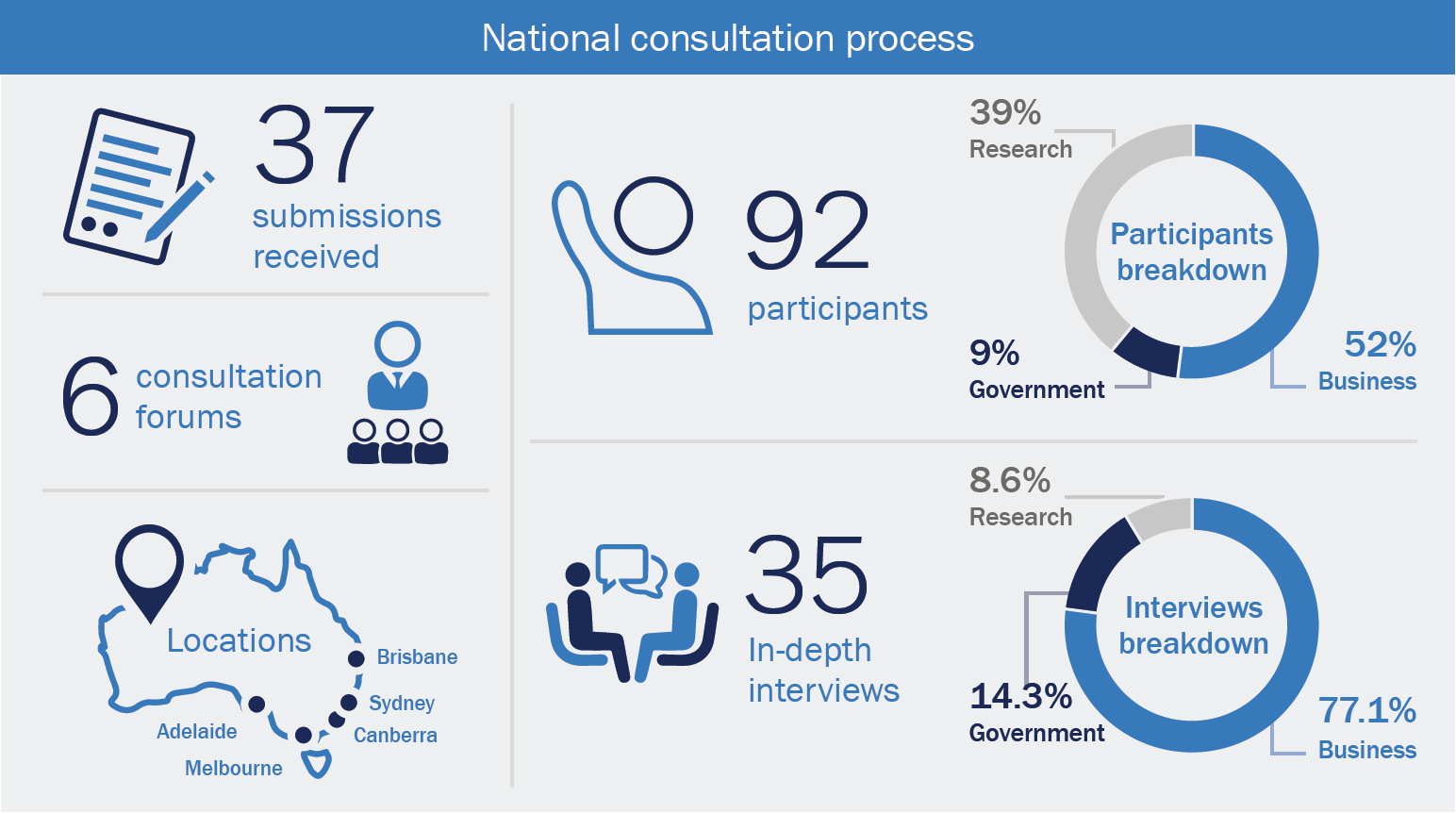
INDUSTRY – We must develop new high-tech firms and a vibrant robotics industry in Australia if we are to maintain our standard of living
Robotic technologies are at the heart of the fourth industrial revolution (Industry 4.0) where the physical and digital worlds converge. The potential of these technologies and the wider digital revolution is highlighted in a range of recent Australian policy statements and analyses, in part because they offer both opportunities and risks for Australia. Global connectivity has reduced the tyranny of distance that kept us apart from the rest of the world, but also presents the challenge of global competition. Our continued standard of living depends on us improving our productivity 2.5% every year. This is impossible to achieve through labour productivity alone, which over the five years to 2015-16 remained at 1.8%. The productivity gap can be narrowed by robotics and automation [PC17]. A recent report by AlphaBeta [ALB17] estimates that automation can boost Australia’s productivity and national income by (up to) $AU2.2 trillion by 2030. This impact would result from improved health and safety, the development of new products and services, new types of jobs and new business models. It will also rely both on how we garner and, in some cases, take a lead on the explosion of technology which will drive robotics.
The boost to Australia’s national income from robot-driven productivity gains through to 2030 are $AU1 trillion from accelerating the rate of automation and $AU1.2 trillion – from transitioning our workforce to higher skilled occupations [ALB17]. By 2025 automation in manufacturing could increase employment by 6% [ALB17] while workplace injuries are set to fall by 11% as dangerous manual tasks are automated [ALB17]. Wages for non-automatable work will be 20% higher and 62% of low-skilled workers will experience increased job satisfaction [ALB17]. Consumers also expect to see robots being used more, with 58% believing that robotics will have a positive impact on society [PwC17].
As noted in Australia 2030: Prosperity through innovation (the Innovation and Science Australia (ISA) 2030 plan), Australia is leading the world in research in cyber-physical systems, computer vision, field robotics, simulation and robotic vision – but as a nation we apply robots very little. Australia ranks 18th in the world in application of industrial robots, with 50% fewer firms engaged in automation compared to leading countries [IFRIR17 ALB17]. The missing piece holding our nation back is in the knowledge and integration space. Companies keen to adopt new technologies either do not have in-house staff to assist with these adoptions or are unable to find the integration partners that they need to successfully harness the benefits of robotics and automation.
We believe Australia has a unique opportunity to take a leading role in the development of robotic technologies and in the tech sector more generally. To demonstrate Australia’s existing capability and to forecast future applications, this document provides recommendations on harnessing the new and emerging technologies being developed in Australia today.
EDUCATION – We can prepare the next generation for the jobs of the future and provide education and upskilling opportunities to equip all Australians with Industry 4.0 relevant skills
While the long-term benefits of transitioning to an Industry 4.0 robot-ready economy are clear – economic growth, wealth creation, job upskilling, diverse job opportunities – short-term dislocation will impact certain occupations across all industries. If robotic technologies follow the tenets of Moore’s Law, then the cost of automation, robotics, and cognitive solutions are bound to continue falling over time, leading to a notable up-tick in adoption rates [DEL17]. One sobering statistic is that 58% of CEOs are considering automation as a way to reduce head count [PwC17]. At the same time that we embrace a robot-ready economy we must also find ways to retrain, and upskill, our workforce and to support occupations that are disrupted.
Consultations during the development of this roadmap repeatedly reinforced the need to be mindful of the disruptive potential of robotics technologies. As noted in recent Australian policy statements, including the ISA 2030 plan, these technologies have the potential to create new industries and new firms, leading to increased export opportunities, improved service delivery, and new jobs across a range of sectors – but there are already understandable concerns about their impact on existing industries and employers, and especially on their employees. These concerns are the focus of a number of the recommendations in this report, which are consistent with the findings of other recent statements – including the ISA 2030 plan, the 2016 National Research Infrastructure Roadmap, and the 2017 Australian Innovation System Report. This roadmap’s recommendations can be addressed through a collaborative, multi-sector approach to the education, funding, and legislative and regulatory frameworks that underpin new industries, with a particular focus on skills and capability development – especially for those already in the workforce.
GOVERNMENT – We have the opportunity to become a testbed for robotics technology by leading the world in ethical, legal and standards frameworks
Australia is a great test-bed for robotics and automation with our vast land mass and low population density, where robots are ideally placed to take on many dirty, dull and dangerous tasks. Our unique geography has led to the development of world-leading field robotics applications. In addition, many of Australia’s regulatory regimes are exemplars for the rest of the world. This provides us with an opportunity to exploit these strengths by developing Australia as a test bed for new technologies taking advantage of our first mover advantage in many areas to develop a true robot economy to benefit Australia.
R&D – We can build national capability in robotics by forming research and technology clusters to develop existing talents and encourage new talent, technology and businesses
We have a significant store of talent in our robotics industry with research communities, small businesses and large corporations. When combined with the right investment, this ecosystem can build, and feed, an innovation pipeline that will realise new robotic vision products, services and businesses. Australia has an opportunity at all stages of the technology value chain, from design and build of robots through to integration and servicing of existing installations. All parts of this value chain need to be considered and supported for Australia to have a vibrant robotics industry that supports automation across all sectors of our economy.
Reducing Australia’s reliance on imported technology, and know-how, to solve critical issues in training and integration are currently preventing many Australian companies from developing the new technologies required to sustain Australia’s economic prosperity. We recommend expanding on Australia’s core capabilities and deepening our talent pool with a concerted investment of energy and resources to develop and support Australia’s fledgling tech sector through the development of technology clusters. As a country we are not big enough to tackle everything but clusters will help focus national effort on the things we are best at. Recruiting global tech giants to this cause by encouraging them to invest in research and development (R&D) and operations in Australia is critical to increase our talent pool and expand our capabilities. The results will be that Australia will create new companies in robotics, forming an important part of the supply chain in all economic sectors.
CULTURE – We must develop an entrepreneurial culture to set moon shot goals and challenges and encourage VC investment in the robotics industry
Investment in robotics start-ups in Australia is low. We need start-up founders with ambitious goals paired with sophisticated investors to develop a thriving robotics eco-system in Australia. The means of achieving this are many but this roadmap highlights two successful approaches – the use of challenges to draw together teams and technology with a specific focus and the development of regional high-tech clusters. The learnings from challenges are transferrable to other uses and we list a range of potential challenges in Appendix 14.1. The success of spinout companies and robotics technologies from some challenges is included among the case studies. The creation of regional high-technology clusters is shown to improve productivity, attract a highly skilled workforce and to attract venture capital due to the reduced risk and increased likelihood of profit to investors.
This roadmap is a living document, symbiotic with a dynamic industry. Its emphasis will shift as the industry develops but always with the intention of navigating a path to prosperity for our nation. By describing what is possible and what is desirable, the roadmap aims to create the grounds for the necessary co-operation to allow robots to help unlock human potential, modernise the economy and build national health, well-being and sustainability.
Roadmap Recommendations
